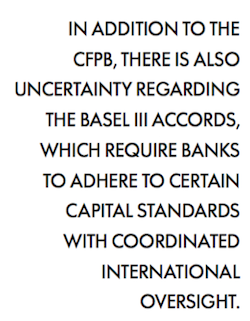What a difference a year makes. At the Mortgage Bankers Association’s National Mortgage Servicing Conference in 2016, the overriding theme was regulatory compliance. Looking ahead to the final mortgage servicing rules from the Consumer Financial Protection Bureau, which were issued in August, servicers were investing significant amounts of time, money and effort to comply.
It was a daunting task, but at least it was clear.
One year later, the election of Donald Trump has thrown the whole compliance equation off balance, leaving servicers to wonder which regulations might be rolled back and how they should operate in a more dynamic regulatory landscape.
It’s safe to say that few predicted a Trump victory and most businesses had made plans with the idea that Hillary Clinton would continue the policies of Pres. Barack Obama, which included strong support for the CFPB and other regulatory bodies.
In the course of one day, however, the certainty of oversight and enforcement was suddenly in question. Now, servicers, along with the rest of the mortgage industry, have to weigh their potential investment against the very real possibility of less, not more, regulation in the next four years.
NO LOVE LOST
From its inception, the CFPB made it clear that servicing was in for a rough ride.
The CFPB was created as part of the Dodd-Frank Wall Street Reform and Consumer Protection Act in 2011. When the bureau released its initial servicing rules in 2013, the bureau’s director, Richard Cordray, said, “For many borrowers, dealing with mortgage servicers has meant unwelcome surprises and constantly getting the runaround. In too many cases, it has led to unnecessary foreclosures. Our rules ensure fair treatment for all borrowers and establish strong protections for those struggling to save their homes.”
Just one month later, the bureau issued another bulletin warning servicers about their obligations in servicing transfers, noting that the CFPB had a “heightened concern” about these practices.
“Consumers should not be collateral damage in the mortgage servicing transfer process,” Cordray stated. “This guidance directs all mortgage servicers, both banks and nonbanks, to follow the laws protecting borrowers from the risks of such transfers, and makes clear that we will be monitoring them for compliance.”
In 2014, during a speech at the MBA’s servicing conference, Steven Antonakes, deputy director of the CFPB, delivered a scathing speech summarizing the bureau’s view of the servicing industry. “Nearly eight years have passed and I remain deeply disappointed by the lack of progress the mortgage servicing industry has made,” Antonakes said.
After outlining a number of problem areas, Antonakes closed with this: “But please understand: if you choose to operate in this space, the fundamental rules have changed forever… We have raised the bar in favor of American consumers and we are ready, willing and able to vigorously enforce that bar.”
 Over the next several years the bureau proved how serious it was about that enforcement, taking decisive action against servicers and continuing to issue guidance.
Over the next several years the bureau proved how serious it was about that enforcement, taking decisive action against servicers and continuing to issue guidance.
By the MBA servicing conference in 2015, Kim Yowell, senior vice president of servicing at BOK Financial, summed up the servicing environment. “In the past, we always served three masters — investors, shareholders and customers. Now we also have compliance.”
Those compliance requirements were expanded even further in 2016 when the CFPB released its final mortgage servicing rule in August. The 900-page rule, which has to be implemented by mid-2018, requires a long list of new servicer actions, including providing certain borrowers with foreclosure protections more than once over the life of the loan, providing more loan information to borrowers in bankruptcy and extending consumer protection to surviving family members.
Cordray reminded servicers at the MBA Annual conference in October 2016 that the CFPB would be monitoring servicer actions in light of the final rule, and said that while some servicers have made good progress, “many troubling issues persist.”
He also took the opportunity to once again call out servicers for their role in the financial crisis. “It is regrettable that much of the damage could have been contained by a more efficient servicing system, but servicers were ill-prepared and unable to address the best interests of their clients — the investors — much less consumers.”
In the frosty relationship between the CFPB and servicers, the regulator has always had a decided advantage. But now the Trump administration has turned the tables, putting the CFPB and its director on notice that they are the targets of intense scrutiny and possible elimination.
What does that mean for servicing?
A NEW DAY
With Trump in the Oval Office, regulatory reform is a certainty. Trump was straightforward during his campaign about his desire to deregulate the financial services industry, and singled out the Dodd-Frank Act early on as overreaching legislation. Before the inauguration, the website for Trump’s transition team listed a number of priority items his administration would tackle, including financial regulatory reform.
“Bureaucratic red tape and Washington mandates are not the answer,” the website states. “The Financial Services Policy Implementation team will be working to dismantle the Dodd-Frank Act and replace it with new policies to encourage economic growth and job creation.”
Singling out the law that created the CFPB generated a backlash from Congressional Democrats, but with Republicans in the majority in both houses, it remains to be seen what Democrats can do to stop the Trump juggernaut.
Cordray would seem to be in the most precarious position. Even before the election, the director and the bureau were under fire, with House Republicans proposing a number of reforms to the bureau in the Financial CHOICE Act, which would replace the director with a multi-member, bipartisan commission.
Cordray’s position was further eroded when the U.S. Court of Appeals for the District of Columbia Circuit handed PHH a victory in its suit against the bureau, declaring the CFPB’s leadership structure unconstitutional and vacating a $103 million fine against PHH.
The CFPB is appealing the PHH ruling, asking the court for an en banc review, but some feel that Trump could fire Cordray even during the appeal process.
For his part, Trump has made his desire to replace Cordray crystal clear, meeting with former Rep. Randy Neugebauer, R-Texas, in January about the post. Neugebauer’s ties to the CFPB go way back, as he was one of the original proponents against the unusual power of the CFPB.
When the bureau was looking for a director back in 2011, Neugebauer expressed his concerns over the agency’s lack of oversight, a concern that’s plagued the agency since its creation.
At the time, before the bureau had a director, Neugebauer tried to pass a law that would merge the CFPB into the Treasury Department.
“Given the significant and perhaps over-regulating powers the CFPB has been given by the Obama administration, Congress must have a say on the appropriation of taxpayer money funding this agency’s operation,” Neugebauer said at the time. The CFPB is currently under the purview of the Federal Reserve Board. Neugebauer said moving the agency will allow Congress to examine the CFPB’s actions and their effects on the overall market.
Meanwhile, if PHH wins its suit against the CFPB, the president will be empowered to remove the director at any time for any reason. Even if that doesn’t happen, under the current law, the president may remove the director for “inefficiency, neglect of duty, or malfeasance in office.”
No president has removed an appointee for cause, but breaking with protocol is a Trump hallmark.
Despite the forces arrayed against him, Cordray shows no sign of leaving of his own accord. CFPB spokesperson Jen Howard said in a statement, “Director Cordray was confirmed by a bipartisan group of 66 senators to serve a term until July 2018 and has no plans to step down.”
Senate Democrats are adamantly fighting back against growing calls for Trump to fire Cordray.
In mid-January, Senate Democratic Leader Charles Schumer, D-New York, Sen. Sherrod Brown, D-Ohio, and Banking Committee Ranking Member Sen. Elizabeth Warren, D-Massachusetts, reinforced their previous assertions that firing Cordray would shatter Trump’s promise to keep Wall Street accountable.
The three senators, along with other Senate Banking Committee Democrats, sent to a letter to Cordray, praising him for his outstanding work as director of the CFPB and emphasizing the need for his leadership at the agency in Trump’s Administration.
Warren emphasized during the call that “no agency has been fired for cause. It’s an extreme and unprecedented step.”
“To make it clear, under Richard Cordray, the CFPB is doing its job on behalf of the American people. The CFPB is working, and Cordray has been a successful leader of the agency,” Warren said.
“If he tries to act outside of the law, there would be a real battle in court. This isn’t the thing where he can say you’re fired and cut to commercial.”
In addition to the CFPB, there is also uncertainty regarding the Basel III accords, which require banks to adhere to certain capital standards with coordinated international oversight.
An article from MLex Market Insight quoted Simon Johnson, a management professor at the Massachusetts Institute of Technology who was chief economist of the International Monetary Fund.
“All the financial regulations will be rolled up and tossed into the wind,” Johnson said. “He [Trump] hasn’t offered details, but the Republican-controlled Congress is considering a bill that would replace the 2010 law.
“That legislation, which has passed the House Financial Services Committee, would provide an ‘off-ramp’ from the Basel III capital and liquidity standards for banks that choose to keep high levels of capital. This is the biggest possible win for Wall Street.”
A December article in Bloomberg echoed that possibility.
“Basel Committee members including the U.S. Federal Reserve and the European Central Bank are under enormous industry pressure to soften the rules,” the article stated.
“The process to put Basel Committee standards into national rules can easily take years to accomplish, however, and this is where Trump and Republicans in the U.S. Congress will have the most sway. Trump will eventually get a chance to install new faces in the Fed, FDIC and the Office of the Comptroller of the Currency, the other U.S. Basel member.”
The article quoted Karen Shaw Petrou, managing partner at Federal Financial Analytics, who said that Trump would be able to influence the process “not only through what Treasury says, but also who comes to be head of the OCC and FDIC and vice chair of supervision at the Fed.
Indeed, with his picks for the EPA and other agencies, Trump has already demonstrated his willingness to appoint leaders of regulatory bodies that could undermine the very mission of those agencies.
Trump’s presidency will defang much of the oversight and enforcement seen since the financial crisis. For servicers, the rough ride just got a whole lot smoother.
See what Mike Jones, director of financial services at Navigant, says servicers should expect now, on page 3.
HERE'S WHAT MORTGAGE SERVICERS CAN DO
Mike Jones, director of financial services at Navigant, which collaborates with banking, insurance and investment management clients to manage opportunities and risks, sat down with HousingWire to discuss what servicers can do in the midst of the uncertain regulatory environment.
Right now, servicers are investing heavily to comply with the new mortgage servicing rules, but this is tempered somewhat by the fact that the bureau is under siege by all three branches of the government and there is a bullseye on Director Cordray’s back, figuratively speaking.
Servicers have roughly a year to 18 months until the mortgage servicing rules start to be enforced. Servicers have to make an assessment of how seriously the bureau is going to be enforcing those rules in the timeframe.
The CFPB has levied billions of dollars in civil money penalties since its inception, so I don’t think servicers can wait and see. They really have to apply themselves right now to prepare for compliance with these rules, because the future is uncertain.
A number of things could happen in the near term. Cordray could be replaced with a five-member commission that is perhaps more business-friendly, and at the same time, Congress could pass legislation to significantly reform the bureau.
If this happens, the question becomes, what will the bureau do with enforcement?
Even if rules remain in place, chances are that in the future there’s going to be less emphasis on enforcement. That doesn’t mean no enforcement, but it could mean not as frequently or aggressively.
Then there’s the possible repeal of Dodd-Frank and that changes the rules. I think that servicers should remain vigilant in their attention to compliance while at the same time keeping an eye on the political environment. When it comes to the government, things usually take time to change.
Some people would say that the CFPB is moving to double down, since it is appealing the recent court case that found its structure unconstitutional. This presents an interesting variable: Are there things that can be done to make the rules more difficult to unwind? That remains to be seen.
Looking at the 2013 mortgage servicing rules, there are nine major areas and four of those — less than half — have substantial process and implementation considerations and implications. In other words, companies will have to do a lot of planning and effort to implement those.
The other five rules are not insignificant, but less so than the four main ones. If I was taking a measured approach to this, I would make sure I did due diligence and prepared to implement the ones with greater operational significance, while remaining aware.
I would at least have a plan for implementation because here’s what going to happen. If the rules don’t change substantially, there will be significant process design system changes to undertake. Not only that, servicers will have to train employees, document the policies and procedures and implement QA procedures that are compliant going forward.
The train is moving already. It’s time for servicers to start to plan what they’re going to do with compliance. If they miss that train and wait too long, they may not have enough time.
They need to have some level of diligence and activity starting now. The big question is how much.



